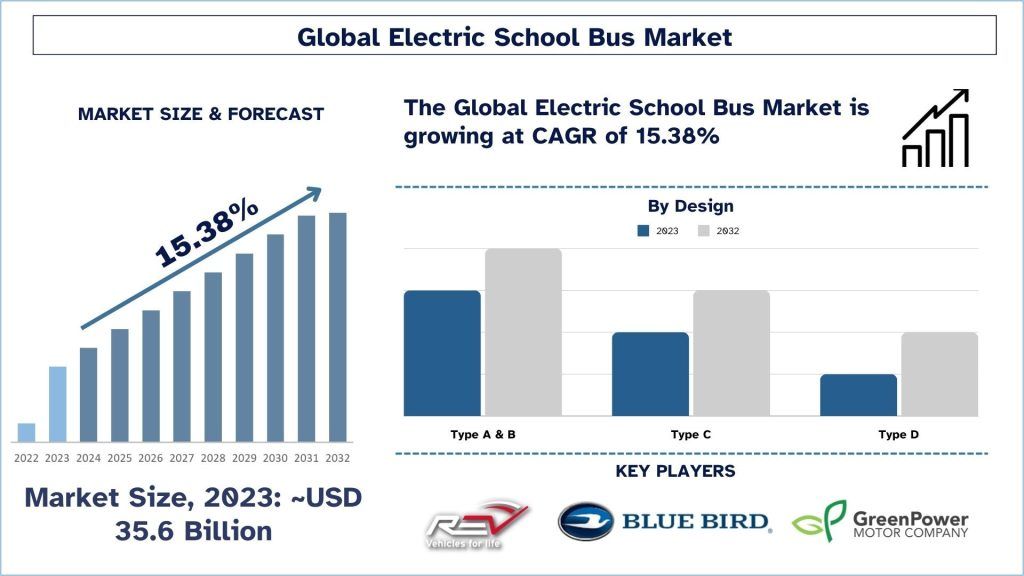- Inicio
- Acerca de nosotros
- Industria
- Servicios
- Leyendo
- Contáctenos
Mercado de Autobuses Escolares Eléctricos: Análisis y Pronóstico Actual (2024-2032)
Énfasis en el Diseño (Tipo A & B, Tipo C y Tipo D); Tipo (Autobús Eléctrico de Batería y Autobús Eléctrico Híbrido); y Región/País
Tamaño y Pronóstico del Mercado Global de Autobuses Escolares Eléctricos
El mercado global de Autobuses Escolares Eléctricos se valoró en USD 35.6 mil millones en 2023 y se espera que crezca a una sólida CAGR de alrededor del 15.38% durante el período de pronóstico (2024-2032) debido a las fluctuaciones en los precios de los combustibles fósiles, lo que lleva a un mayor interés en las alternativas eléctricas, que ofrecen costos operativos más predecibles.
Análisis del Mercado de Autobuses Escolares Eléctricos
El mercado de autobuses escolares eléctricos se define como el segmento de negocio emergente para vender y utilizar autobuses escolares eléctricos para el transporte de estudiantes como un medio de transporte más respetuoso con el medio ambiente que los autobuses que utilizan diésel. Este mercado está impulsado por la creciente preocupación por los problemas ambientales, la tendencia hacia la reducción de las emisiones de gases de efecto invernadero y la búsqueda de una mejor calidad del aire, especialmente en las escuelas circundantes. Los factores que impulsan el crecimiento incluyen otros factores como subvenciones, subsidios y emisiones que impulsan a los distritos escolares a adoptar flotas eléctricas. Además, las mejoras en la tecnología de baterías, así como la disminución de los costos de los vehículos eléctricos y los continuos gastos de capital en infraestructura de vehículos eléctricos, impulsan la expansión del mercado. La transición a los vehículos eléctricos está ejecutando un cambio de ritmo con otros países para reducir el calentamiento global y mejorar la salud de las personas.
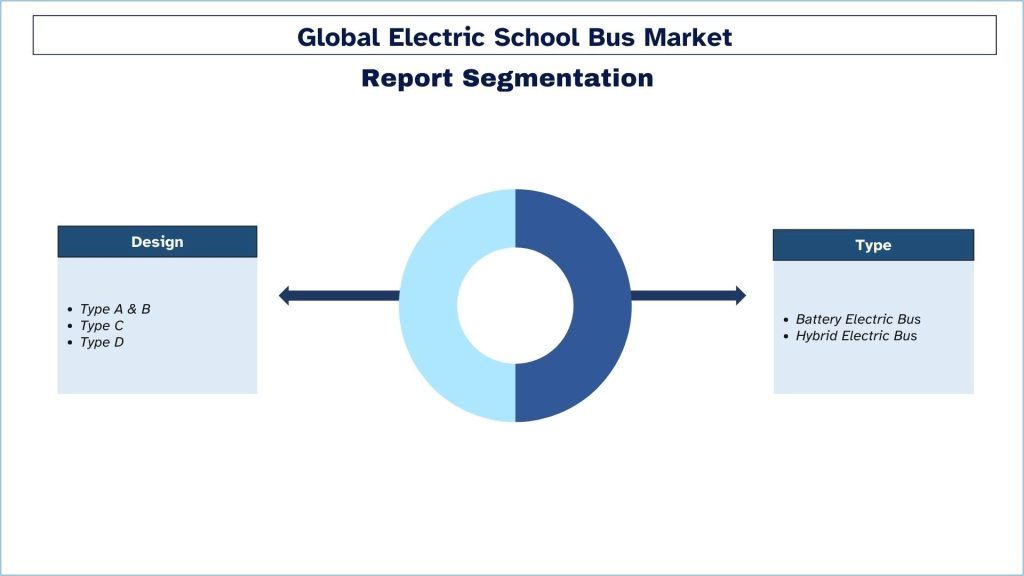
Tendencias del Mercado Global de Autobuses Escolares Eléctricos
Esta sección analiza las tendencias clave del mercado que están influyendo en los diversos segmentos del mercado global de Autobuses Escolares Eléctricos, según lo encontrado por nuestro equipo de expertos en investigación.
Segmento de Autobuses Eléctricos de Batería que Transforma la Industria
El segmento de autobuses eléctricos de batería es uno de los más importantes para el mercado de autobuses escolares eléctricos debido a su capacidad de cero emisiones, los costos operativos reducidos y el creciente apoyo gubernamental al transporte de energía limpia. Además, la mejora de la tecnología de baterías está aumentando la capacidad de autonomía, acortando la duración de la carga y disminuyendo los costos de los autobuses escolares eléctricos, haciéndolos factibles y atractivos para los distritos escolares. Estos incluyen incentivos, subvenciones y también mandatos que los gobiernos imponen a las partes interesadas para cambiar sus flotas a eléctricas, lo que también impulsa el crecimiento del segmento BEB en este mercado.
Se Espera que América del Norte Domine el mercado durante el período de pronóstico.
Se espera que el mercado de autobuses escolares eléctricos en América del Norte crezca a un ritmo alto durante el período debido a la creciente conciencia ambiental y el apoyo gubernamental mejorado para proyectos de energía limpia. Las iniciativas de Autobuses Eléctricos están aumentando en los distritos escolares estadounidenses y canadienses para disminuir la emisión de gases de efecto invernadero y mejorar los estándares ambientales en regiones densamente pobladas. Las principales fuerzas impulsoras incluyen el apoyo gubernamental en forma de asistencia financiera y límites de CO2 más bajos. Además, las mejoras en la tecnología de baterías y el crecimiento en la disponibilidad de servicios para cargar vehículos eléctricos significan que la utilización de autobuses escolares eléctricos es altamente factible y económica. Por lo tanto, el mercado aún tiene un alto potencial de crecimiento a medida que más escuelas comienzan a buscar soluciones de transporte respetuosas con el medio ambiente.
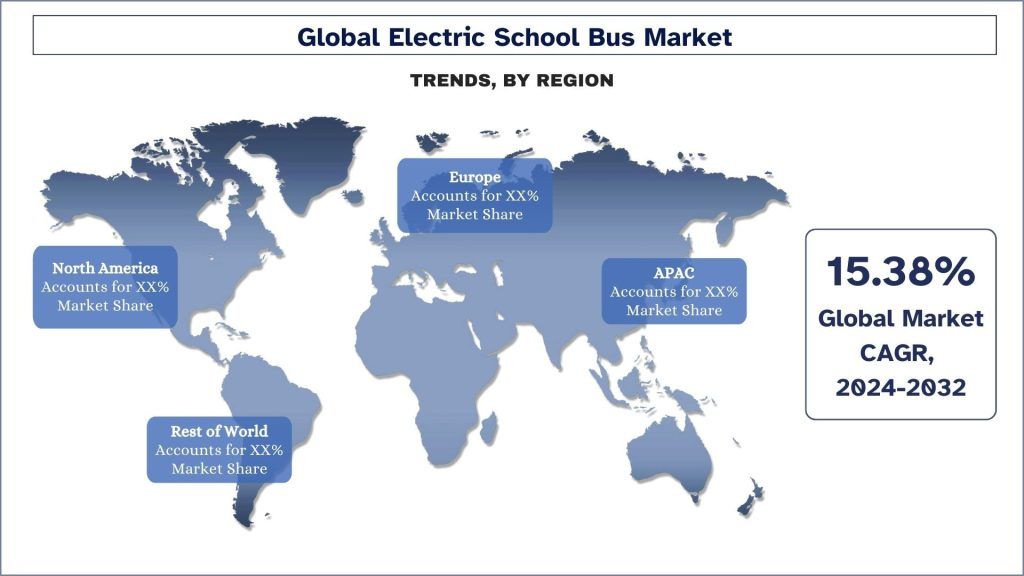
Visión General de la Industria Global de Autobuses Escolares Eléctricos
El mercado global de autobuses escolares eléctricos es competitivo, con varios actores del mercado globales e internacionales. Los actores clave están adoptando diferentes estrategias de crecimiento para mejorar su presencia en el mercado, como asociaciones, acuerdos, colaboraciones, lanzamientos de nuevos productos, expansiones geográficas y fusiones y adquisiciones. Algunos de los principales actores del mercado son BYD Motors; Blue Bird Corporation; Lion Electric Company; GreenPower Motor Company; Trans Tech Bus; Daimler Buses GmbH; y REV Group.; Collins Bus Corporation; Motiv Power Systems, Inc.; INTERNATIONAL MOTORS, LLC
Cobertura del Informe del Mercado Global de Autobuses Escolares Eléctricos
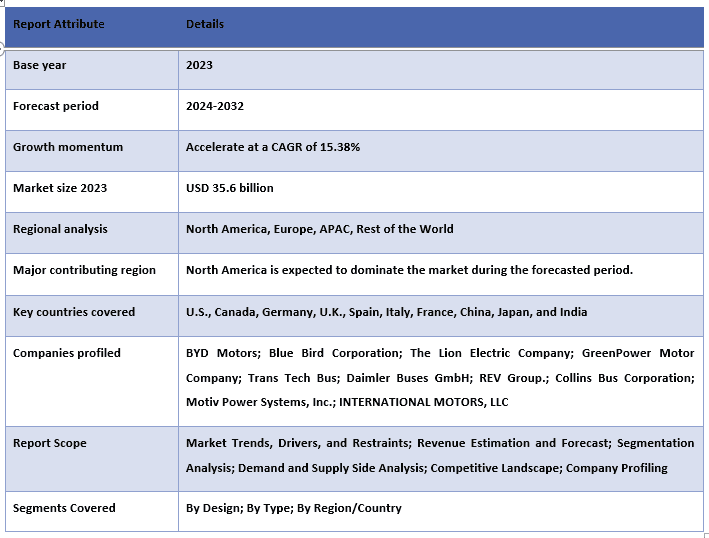
Razones para comprar este informe:
- El estudio incluye análisis de dimensionamiento y pronóstico del mercado confirmados por expertos clave de la industria autenticados.
- El informe revisa brevemente el rendimiento general de la industria de un vistazo.
- El informe cubre un análisis en profundidad de pares de la industria prominentes, centrándose principalmente en las finanzas comerciales clave, las carteras de tipos, las estrategias de expansión y los desarrollos recientes.
- Examen detallado de los impulsores, restricciones, tendencias clave y oportunidades que prevalecen en la industria.
- El estudio cubre exhaustivamente el mercado en diferentes segmentos.
- Análisis a nivel regional en profundidad de la industria.
Opciones de personalización:
El mercado global de autobuses escolares eléctricos se puede personalizar aún más según el requisito o cualquier otro segmento del mercado. Además de esto, UMI entiende que puede tener sus propias necesidades comerciales, por lo tanto, no dude en contactarnos para obtener un informe que se adapte completamente a sus necesidades.
Tabla de contenido
Metodología de Investigación para el Análisis del Mercado Global de Autobuses Escolares Eléctricos (2024-2032)
Analizar el mercado histórico, estimar el mercado actual y pronosticar el mercado futuro del mercado global de Autobuses Escolares Eléctricos fueron los tres pasos principales emprendidos para crear y analizar la adopción del Autobús Escolar Eléctrico global en las principales regiones. Se realizó una extensa investigación secundaria para recopilar las cifras históricas del mercado y estimar el tamaño actual del mercado. En segundo lugar, para confirmar estos conocimientos, se consideraron numerosos hallazgos y supuestos. Además, se realizaron exhaustivas entrevistas primarias con expertos de la industria en toda la cadena de valor del mercado global de Autobuses Escolares Eléctricos. Para la suposición y validación de los números del mercado a través de entrevistas primarias, empleamos un enfoque de arriba hacia abajo/de abajo hacia arriba para pronosticar el tamaño completo del mercado. Posteriormente, se adoptaron métodos de desglose del mercado y triangulación de datos para estimar y analizar el tamaño del mercado de segmentos y subsegmentos de la industria. El método detallado se explica a continuación:
Análisis del Tamaño Histórico del Mercado
Paso 1: Estudio en Profundidad de Fuentes Secundarias:
Se realizó un estudio secundario detallado para obtener el tamaño histórico del mercado del mercado global de Autobuses Escolares Eléctricos a través de fuentes internas de la empresa, como informes anuales y estados financieros, presentaciones de desempeño, comunicados de prensa, etc., y fuentes externas que incluyen revistas, noticias y artículos, publicaciones gubernamentales, publicaciones de la competencia, informes del sector, bases de datos de terceros y otras publicaciones creíbles.
Paso 2: Segmentación del Mercado:
Después de obtener el tamaño histórico del mercado del mercado global de Autobuses Escolares Eléctricos, realizamos un análisis secundario detallado para recopilar conocimientos históricos del mercado y participación para diferentes segmentos y subsegmentos para las principales regiones. Los principales segmentos incluidos en el informe, como diseño, tipo y región. Además, se realizaron análisis a nivel de país para evaluar la adopción general de modelos de prueba en esa región.
Paso 3: Análisis de Factores:
Después de comprar el tamaño histórico del mercado de diferentes segmentos y subsegmentos, realizamos un análisis de factores detallado para estimar el tamaño actual del mercado del mercado global de Autobuses Escolares Eléctricos. Además, realizamos un análisis de factores utilizando variables dependientes e independientes como diseño, tipo y regiones del mercado global de Autobuses Escolares Eléctricos. Se realizó un análisis exhaustivo de los escenarios de la oferta y la demanda considerando las principales asociaciones, fusiones y adquisiciones, expansión comercial y lanzamientos de productos en el mercado global de Autobuses Escolares Eléctricos.
Estimación y Pronóstico del Tamaño Actual del Mercado
Dimensionamiento actual del mercado: Basado en conocimientos prácticos de los 3 pasos anteriores, llegamos al tamaño actual del mercado, los actores clave en el mercado global de Autobuses Escolares Eléctricos y la cuota de mercado de los segmentos. Todas las cuotas de porcentaje requeridas y los desglose del mercado se decidieron utilizando el enfoque secundario mencionado anteriormente y se verificaron a través de entrevistas primarias.
Estimación y pronóstico: Para la estimación y el pronóstico del mercado, se asignaron pesos a varios factores, incluidos los impulsores y las tendencias, las restricciones y las oportunidades disponibles para las partes interesadas. Después de analizar estos factores, se aplicaron técnicas de pronóstico relevantes, es decir, el enfoque de arriba hacia abajo/de abajo hacia arriba para llegar al pronóstico del mercado 2032 para diferentes segmentos y subsegmentos en los principales mercados a nivel mundial. El método de investigación adoptado para estimar el tamaño del mercado abarca:
El tamaño del mercado de la industria, en términos de ingresos (USD) y la tasa de adopción del mercado global de Autobuses Escolares Eléctricos en los principales mercados a nivel nacional
Todas las cuotas porcentuales, divisiones y desglose de los segmentos y subsegmentos del mercado
Actores clave en el mercado global de Autobuses Escolares Eléctricos en términos de tipos ofrecidos. Además, las estrategias de crecimiento adoptadas por estos actores para competir en el mercado de rápido crecimiento.
Validación del Tamaño y la Cuota de Mercado
Investigación Primaria: Se realizaron entrevistas en profundidad con los líderes de opinión clave (KOL), incluidos los ejecutivos de alto nivel (CXO/VPs, Jefe de Ventas, Jefe de Marketing, Jefe Operacional, Jefe Regional, Jefe de País, etc.) en las principales regiones. Los resultados de la investigación primaria se resumieron y se realizó un análisis estadístico para probar la hipótesis establecida. Las aportaciones de la investigación primaria se combinaron con los hallazgos secundarios, convirtiendo así la información en conocimientos prácticos.
División de Participantes Primarios en Diferentes Regiones
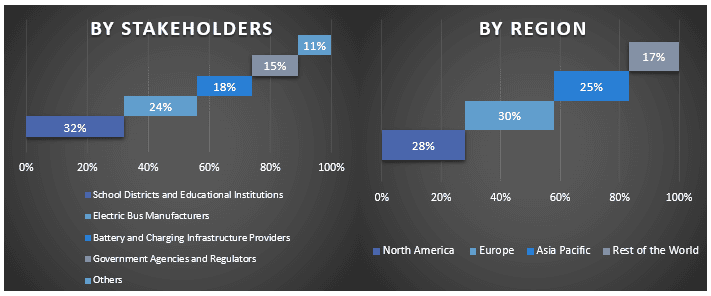
Ingeniería de Mercado
Se empleó la técnica de triangulación de datos para completar la estimación general del mercado y llegar a números estadísticos precisos para cada segmento y subsegmento del mercado global de Autobuses Escolares Eléctricos. Los datos se dividieron en varios segmentos y subsegmentos después de estudiar varios parámetros y tendencias en el diseño, el tipo y las regiones del mercado global de Autobuses Escolares Eléctricos.
El Objetivo Principal del Estudio de Mercado Global de Autobuses Escolares Eléctricos
Las tendencias actuales y futuras del mercado del mercado global de Autobuses Escolares Eléctricos se identificaron en el estudio. Los inversores pueden obtener información estratégica para basar su discreción para las inversiones en el análisis cualitativo y cuantitativo realizado en el estudio. Las tendencias actuales y futuras del mercado determinaron el atractivo general del mercado a nivel regional, proporcionando una plataforma para que el participante industrial explote el mercado sin explotar para recibir ayuda de una ventaja del primero en actuar. Otros objetivos cuantitativos de los estudios incluyen:
- Analizar el pronóstico actual y el tamaño del mercado del mercado global de Autobuses Escolares Eléctricos en términos de valor (USD). Además, analizar el pronóstico actual y el tamaño del mercado de diferentes segmentos y subsegmentos.
- Los segmentos en el estudio incluyen áreas de diseño, tipo y regiones.
- Definir y analizar el marco regulatorio para la industria.
- Analizar la cadena de valor involucrada con la presencia de varios intermediarios, junto con el análisis de los comportamientos de los clientes y la competencia de la industria.
- Analizar el tamaño actual y pronosticado del mercado global de autobuses escolares eléctricos para las principales regiones.
- Los principales países de las regiones estudiadas en el informe incluyen Asia Pacífico, Europa, América del Norte y el Resto del Mundo.
- Perfiles de empresas del mercado global de autobuses escolares eléctricos y las estrategias de crecimiento que los actores adoptan para sostener el mercado de rápido crecimiento.
- Análisis a nivel regional en profundidad de la industria
Preguntas frecuentes Preguntas frecuentes
P1: ¿Cuál es el tamaño actual del mercado global de Autobuses Escolares Eléctricos y su potencial de crecimiento?
P2: ¿Cuáles son los factores impulsores del crecimiento del mercado global de Autobuses Escolares Eléctricos?
P3: ¿Qué segmento tiene la mayor cuota de mercado global de Autobuses Escolares Eléctricos por categoría de tipo?
P4: ¿Cuáles son las tecnologías y tendencias emergentes en el mercado global de Autobuses Escolares Eléctricos?
P5: ¿Qué región dominará el mercado global de Autobuses Escolares Eléctricos?
Relacionados Informes
Los clientes que compraron este artículo también compraron

